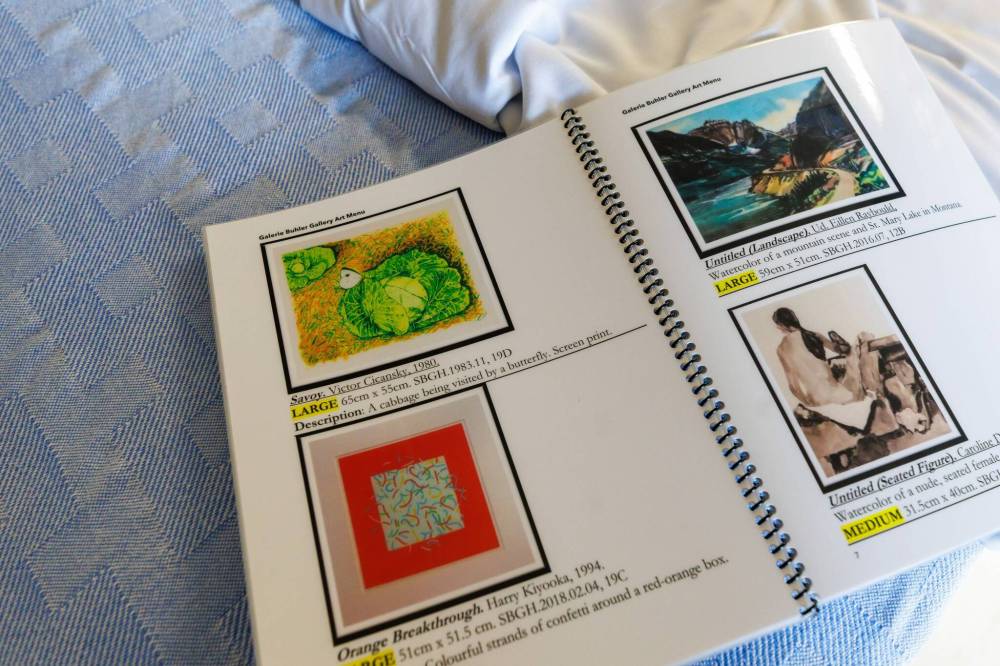Health
New Art Program at St. Boniface Hospital Enhances Patient Healing

Patients in hospitals often face a challenging environment filled with medical equipment and clinical routines, making moments of peace scarce. To address this issue, St. Boniface Hospital in Winnipeg, Manitoba, has launched a new art program aimed at enhancing the healing process through art. This initiative allows patients to select artwork for their rooms from a carefully curated menu, providing them with a sense of autonomy during their hospital stay.
The program, spearheaded by Hannah Godfrey, curator of the hospital’s Galerie Buhler Gallery, features 16 paintings created by Manitoba artists. These pieces vary in style, from serene natural landscapes to abstract designs, all intended to uplift patients’ spirits and promote emotional well-being. “Here, the art is actually working. It’s doing heavy lifting,” Godfrey emphasized.
Patients can choose a piece of art from the menu, which will remain in their room until discharge. If they wish to change the artwork, they are free to select another piece. This flexibility has been well-received, according to both patients and hospital staff. The initiative not only beautifies the hospital environment but also serves as a therapeutic tool, reducing stress and anxiety.
Sandra Torchia, the hospital’s director of health services for mental health, renal health, and palliative care, believes that art can significantly impact physical and mental well-being. “Art helps decrease stress, anxiety, and pain levels. It gives you resilience, motivating you to continue on better pathways towards feeling better,” she stated. This sentiment echoes the historical acknowledgment of art’s value in healthcare made by Florence Nightingale in 1859, when she noted the tangible effects of color and form on patient recovery.
The hospital’s expansive art collection consists of over 400 works, and the new program aims to utilize these pieces effectively. For patients bedridden for extended periods, the program ensures that they can enjoy art in their own space, breaking down barriers that previously limited access to the hospital’s artistic offerings. “With the patient art menu, we’re transcending all the barriers for patients and families and staff who can’t come down to benefit from the art,” Torchia explained.
Although the program is still in its early stages, it has garnered interest among hospital management and staff. Godfrey’s vision goes beyond just displaying art; she hopes to create transformative experiences for patients. “Art can reflect experience, it can give people a means of expressing what they’re going through,” she noted. The impact of this initiative is under consideration for future research, as the hospital plans to study the effects of art on healing outcomes.
Katie North, the hospital’s manager of health services, is particularly optimistic about the program’s potential. She has collaborated with Godfrey on previous projects and believes that a research-based approach could further demonstrate how art influences patient experiences positively. “Art can potentially alter a mindset to a more positive outlook, which can improve patient outcomes,” North said.
While not every long-term patient may be eligible to select art for their room—decisions depend on medical conditions and duration of stay—the program is designed to be inclusive. Godfrey is mindful of the space constraints in hospital rooms when selecting new works for the menu. “The size will inform some of my acquisitions,” she acknowledged.
Plans are underway to extend this innovative art initiative to the McEwen Building, which focuses on mental health services. Here, adaptations will be necessary to ensure that the artworks can be displayed safely. Godfrey is exploring the possibility of reproducing certain pieces onto vinyl wallpaper, which can be safely adhered to walls, allowing patients to benefit from art in a secure manner.
As St. Boniface Hospital continues to pioneer this approach to healing, the integration of art into patient care stands as a testament to the evolving understanding of holistic health. This program not only brings beauty to an often sterile environment but also fosters emotional connections, ultimately enhancing the recovery journey for many.
-

 World3 months ago
World3 months agoScientists Unearth Ancient Antarctic Ice to Unlock Climate Secrets
-

 Entertainment3 months ago
Entertainment3 months agoTrump and McCormick to Announce $70 Billion Energy Investments
-

 Science3 months ago
Science3 months agoFour Astronauts Return to Earth After International Space Station Mission
-

 Lifestyle3 months ago
Lifestyle3 months agoTransLink Launches Food Truck Program to Boost Revenue in Vancouver
-

 Technology2 months ago
Technology2 months agoApple Notes Enhances Functionality with Markdown Support in macOS 26
-

 Top Stories7 days ago
Top Stories7 days agoUrgent Update: Fatal Crash on Highway 99 Claims Life of Pitt Meadows Man
-

 Sports3 months ago
Sports3 months agoSearch Underway for Missing Hunter Amid Hokkaido Bear Emergency
-

 Politics2 months ago
Politics2 months agoUkrainian Tennis Star Elina Svitolina Faces Death Threats Online
-

 Technology3 months ago
Technology3 months agoFrosthaven Launches Early Access on July 31, 2025
-

 Politics3 months ago
Politics3 months agoCarney Engages First Nations Leaders at Development Law Summit
-

 Entertainment3 months ago
Entertainment3 months agoCalgary Theatre Troupe Revives Magic at Winnipeg Fringe Festival
-

 Politics1 week ago
Politics1 week agoShutdown Reflects Democratic Struggles Amid Economic Concerns





















